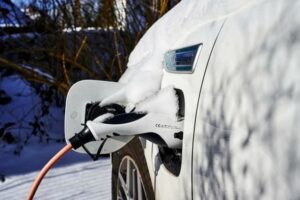The Cure for EV Range Anxiety Is Coming

By Ben Z. Rose
Dec 27, 2023, 2:00 am EST
 Of all the obstacles to broader adoption of electric vehicles, the lack of publicly available car chargers is the one cited most frequently. If we are to believe industry pundits, traditional car drivers are scared to death of buying an EV for fear of draining the battery and getting stuck on the side of the road of some backwoods hamlet, or worse, getting ensnared in city traffic. The fear of an empty battery has led to a condition commonly referred to as range anxiety. And it persists, despite the industry’s best efforts to treat it.
Of all the obstacles to broader adoption of electric vehicles, the lack of publicly available car chargers is the one cited most frequently. If we are to believe industry pundits, traditional car drivers are scared to death of buying an EV for fear of draining the battery and getting stuck on the side of the road of some backwoods hamlet, or worse, getting ensnared in city traffic. The fear of an empty battery has led to a condition commonly referred to as range anxiety. And it persists, despite the industry’s best efforts to treat it.
Great strides have been made to extend EV battery life in the last few years. It’s unusual today for an EV to have a charging range of less than 250 miles, with 300 miles or more increasingly common. This is farther than many cars and pickup trucks can drive on a single tank of gas. Moreover, the number of publicly available charging stations is rising, with the ratio of EVs to charging ports falling rapidly. Even fast chargers are now rising as a portion of charger infrastructure. Fast chargers are like highway gas stations for EVs—they let drivers pull in and quickly refill most of their charge.
In Massachusetts, for example, EVs make up about 1% of all registered light vehicles. The state has one fast charger for every 75 EVs, while the ratio of registered light vehicles to gasoline pumps is one to 196 (assuming 10 pumps per gas station). And more innovations are in the works: Members of AAA can now obtain roadside EV charging services in 15 cities around the U.S., including West Springfield, Mass.
Yet there remain real reasons to worry about taking an EV out on a road trip. First of all, the number of fast chargers is greatly skewed in favor of urban, versus rural areas. Most charging stations have only one or two charging ports, and since even fast charging can take 15-45 minutes depending on the battery, lines can form quickly. That can get stressful when many charging facilities are unmanned and fully self-service. By contrast, there is hardly ever a line at the local gas station, or at a Cumberland Farms, which may have as many as 16 pumps working at once. It’s also nice to know that if you have a problem with your credit card, there’s a person on premise in the form of a cashier or attendant that can resolve it. Being able to buy a bag of peanuts, a cup of coffee, or use the restroom, is of course a bonus.
This stands in contrast to many EV chargers, which have difficulty reading a credit card. This assumes that the charger is in working order when you reach it. Far too many are not. And getting to one is not an easy feat either, especially when it’s located away from a main highway, tucked away in the back of a motel, school, or even a shopping center. Tesla drivers have it easier, with access to a more-reliable, national network. But drivers of EVs from one of the automakers also need to worry whether their EV will work with the available charger’s plug. No one ever needs to worry about whether a gasoline pump will fit into their tank.
Fortunately, help is on the way. Tesla’s clever decision to open a portion of its fast charger network (and thus defray the costs of operating it) to other manufacturers, including GM, Ford, Volvo, Mercedes-Benz, Nissan, Honda Motor, BMW, Toyota, Rivian Automotive, and several others, will help to alleviate the problem. Tesla has also made its charging standard available to charger manufacturers. This could both increase the availability and reliability of chargers, in much the same way that Microsoft’s decision to open up its Windows user interface to other software makers made it easier to write software for a larger audience.
Indeed, the time will come—perhaps only in a few years—when EV Range Anxiety can not only be treated, but cured. Until that day arrives, those still on the fence about buying an EV can focus on other pet peeves, such as the still-high unsubsidized price of most EVs, the poor performance of in-car electronics, fear of losing battery life in cold weather, and, for some models, the high cost of repairs.
Guest commentaries like this one are written by authors outside the Barron’s and MarketWatch newsroom. They reflect the perspective and opinions of the authors. Submit commentary proposals and other feedback to ideas@barrons.com.

